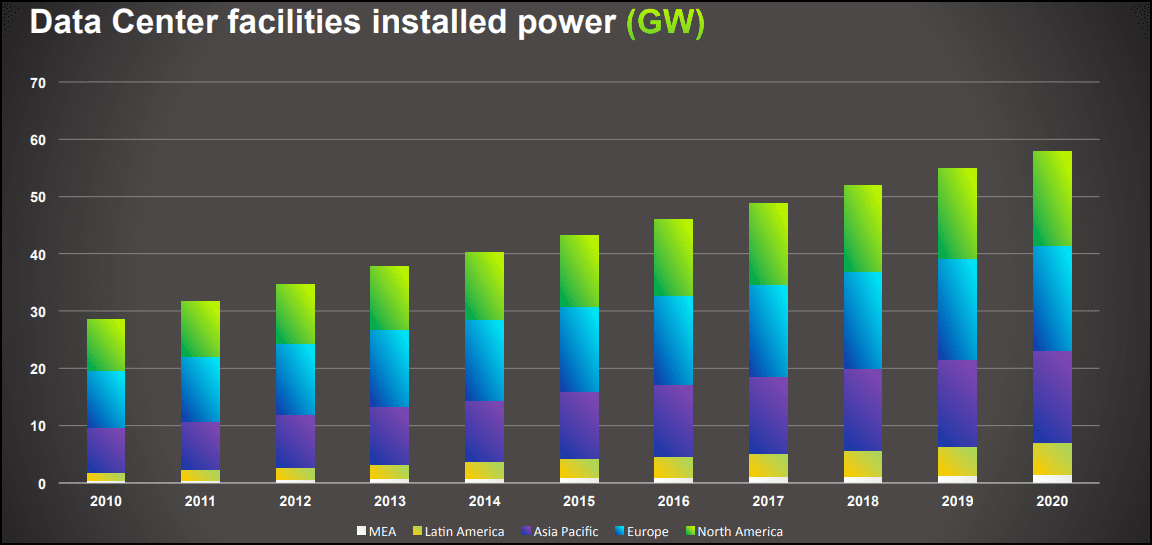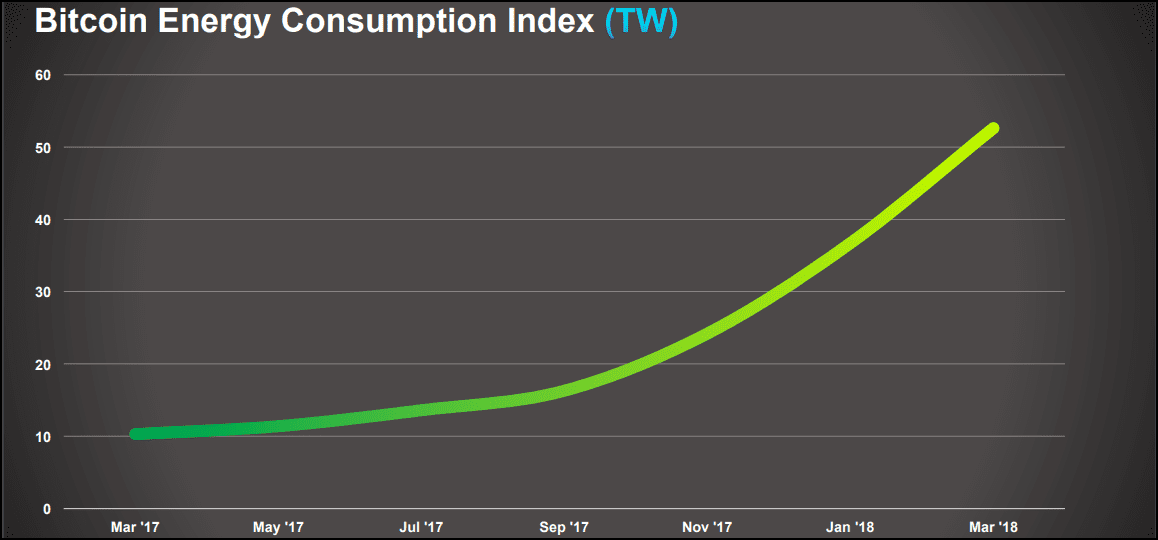Real-time video streaming, online gaming as well as mobile devices already account for 60% of all data traffic, and it is predicted that this will rise to 80% by 2020 – ACEEE Summer Study on Energy Efficiency in Buildings.
In our always on life style- whether we like something on Facebook, stream the latest movie or post on Instagram, we generate huge amount of data. Every online activity involves massive amounts of data that’s stored in different datacenters, ranging from small closets to large server rooms to mammoth like cloud datacenters.
Datacenters power our connected devices and store billions of gigabytes of data which we and business organizations use, to meet our daily transaction processing needs, across the globe. These datacenters house IT equipment – servers, networking and storage equipment, and consume massive energy to run them and to cool the heat which dissipates from the IT equipment.
“Cooling is by far the biggest user of electrical power in the data center,” says Steve Carlini, global director of data center solution marketing at Schneider Electric, a vendor of data center power and cooling products. “That area may take up to 40 or 50 percent of all the power going into your data center.”
Global datacenter energy consumption is increasing as data centers usually run round the clock, throughout the year and consume roughly 3% of all the globally generated power. They generate approximately 4% of greenhouse gas emissions, and this places ICT industry at par with the airline industry. Global CO2 emissions of data centers are estimated to have the fastest growing carbon footprint from across the whole ICT sector.
The intense power requirements needed to run and cool data centers now account for almost a quarter of global carbon dioxide emissions from ICT, according to analyst firm Gartner.
How much energy does a server farm/ data center consume?
According to a report by Lawrence Berkeley National Laboratory, data centers are on track to use 73 billion kwh by 2020. If not for increase in efficiency since 2010, data centers would likely be using 200 billion kwh by 2020. They predict that data center energy use will grow by 4% between 2014 and 2020.

The power draw for data centers range according to their sizes. For a rack of servers in a closet, power draw is few kilowatts and it is several tens of Megawatt for large data centers. They consume electricity equivalent to be used by a small town. This growing energy consumption is one of the biggest data center power problems.
As stated above, it can not only be attributed primarily to the IT demands and cooling equipment, but to lighting, power distribution and other requirements as well. The cooling system accounts for up to 40% in average of the energy, with the most efficient systems using 24% of the total energy and the least efficient 61%.
The datacenter power is distributed to chillers, cooling towers and water pumps.
Water chillers are the most energy-consuming since they supply chilled water to the cooling coil in order to keep the indoor temperature low enough to remove the heat emitted by the servers and other equipment.
Datacenters, Cooling and Technological Advances
Over the last few years, the demand for data centers among cloud service providers, enterprises, government agencies, colocation providers and telecommunication organizations has increased exponentially due to the adoption of advanced technologies such as cloud-based services for their operational business needs.
Also, there has been a rapid growth of new technological trends like big data analytics, Artificial Intelligence/machine learning, cryptocurrencies and Internet of Things.
This rapid growth of machine learning and AI applications is contributing to the building up of new services, enhanced products and is also boosting demand for powerful high – performance computing hardware. This rising popularity in turn is driving demand for more data centre space and have design implications for high-density racks to be powered and cooled.
Bitcoin mining also burns huge amount of electricity. Below screengrab shows the rising index of Bitcoin energy consumption.

Thus, the trends of increasing data center capacity and power use by information technology equipment, re-emphasize the need to reduce cooling load and data centre PUE to form green data centers/green IT.
What is PUE? Power usage effectiveness(PUE) is the metric used to determine data centre energy efficiency. An ideal PUE is 1.0. which indicates the maximum attainable efficiency with no overhead energy.
Datacenter cooling solutions – Traditional (Air Cooling) vs Liquid immersion cooling
Cooling solutions are an integral part of data centers and they can be classified into two types namely, air-based and liquid-based cooling.
| Air based cooling | Liquid immersion cooling |
| Hard to reduce PUE under 2 | PUE of less than 2 |
| Air circulation is uneven | Coolant is evenly pumped through the pod |
| Installation costs are large | 25% less implementation costs as compared to air solution |
| Raised flooring requirements | No raised floorings |
| Large server rooms require extra air fans | No need to move any air |
| Hardware requires fans | Does not require fans |
| Air pushes hazardous particles | Sealed and clean environment |
| Noisy environment – Fans and Indoor units generate more than 80db noise | Silent operation environment |
Why immersion cooling is imminent to power the next generation datacenters?
With air based datacenter cooling methods, cooling high-density racks is very difficult, and a complete server room is full of high-density racks.
Liquid immersion cooling deployed datacenters are more compact, modular, green and highly efficient. They save up to 99 percent electricity than traditional data center cooling which uses chillers, heat pump and HVAC.
Server immersion cooling allows companies to drastically reduce their data center energy load, irrespective of their PUE. Hardware or servers are kept submerged in a liquid (generally oil based) which is dielectric and thermally conductive.
This liquid submersion cooling technology allows data centers to use evaporative or adiabatic cooling towers instead of chiller-based air cooling.
Use cases: Current commercial applications for immersion cooling range from data center oriented solutions for commodity server cooling, bitcoin mining, server clusters, HPCC applications, cloud-based and web hosting architectures.
Thus, demand for these oil-based data center solutions is on the rise and offerings too have become more professionalized.
Barcelona based Immersion cooling solution startup, Submer Technologies need a special mention here for their oil-based data center product.
Submer- A way to socially responsible data centers
Submer has developed a cooling solution for data centers based on immersion cooling, keeping in mind the pains of operating hardware in data centers. Submer’s immersion cooling solution uses coolant fluid which is 100% biodegradable dielectric fluid and ensures best PUE of 1.03.
This server cooling system by Submer helps its users to achieve >45% savings on traditional electricity bill and hyper scaler efficiency.

It allows datacenters to extract 5o KW heat capacity in 22u format.

Product helps in increasing computing density per sqm. It can be put next to racks. Thus, users can save 75% of the space by placing more units one by the other. Each device has 50 KW heat dissipating capacity.
You can scale it to any volume in a very small space as it is 1mx 120.

Use cases: Any infrastructure or hardware. Built for hosters, cloud providers, regular datacenters, edge computing, cryptocurrency mining, blockchain and research datacenters.
“It’s mainly the mindset that needs to be changed, everyone is used to air- based cooling systems and its kind from 6os we have been working from the same way, but working with a fluid is just as comfortable as we have designed it in a way that extracting a server placing it or maintenance rails being able to switch some hardware and dipping it back in takes you exactly the same time that it would be in an air basis.so it’s easy to use and integrate. You can retrofit existing hardware running in base tracks very easily into existing data center infrastructure or deployed as stand-alone”.- Daniel Pope, Co-founder & CEO, Submer.
SmartPod and Crypto pod: Two solutions in two sizes
- SmartPod: This datacenter immersion cooling solution is optimized for variable workloads. It comes in a 22u and 45u configuration to dissipate 25kW – 50kW plus. SmartPod 45u is for medium density servers and Smart Pod 22u for HPC / high density computing.
- CryptoPod: This product is built specifically for crypto blockchain and is optimized for always-on workloads like bitcoin BTC / cryptocurrency mining, blockchain.
Many data center operators struggle with data centre management with increased OPEX year-over-year due to increased power consumption by cooling systems but Submer promises ROI in less than a year.
Thus, with immersion cooling deployment, the green revolution technology, data center operators can build data center facilities to deliver high efficiency and reduce power consumption.









Hello my friend! I want to say that this article is awesome, nice written and include
almost all important infos. I’d like to peer extra posts like this .